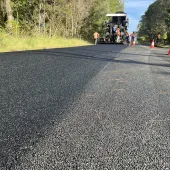Level Measurement for Safe and Efficient Operation of Bitument Tanks

First published in the June 2017 issue of Quarry Management as The Next Level
Accurate and effective level measurement is key to the safe and efficient operation of bitumen tanks. Doug Anderson, marketing manager with VEGA Controls Ltd, takes a look at what makes an effective level-measurement system
Storing and offloading bitumen is a hazardous and necessarily complex operation that must adhere to the highest safety standards to prevent overfilling and spillage, and to protect people. This article looks at a key part of this operation – level measurement. Get this right and the system behind will function correctly and safely, but what are the main things to look out for?
Sensor choice
Getting it right: Poor sensor selection is not uncommon, and neither is incorrect calibration, which can be affected by changing density, temperature and, of course, build-up. Understanding how the sensors operate and what they measure helps in avoiding wrong data, unsafe operation, production outages and, perhaps, expensive repeat visits by engineers.
The density/volume per tonne of bitumen changes at varying temperatures and grades (PEN), for example cooler-temperature bitumen from the tanker compared with bitumen in a fully heated tank. If choosing a pressure (weight) or volume-based device, this effect needs to be understood because of the potential for undetected changes in the liquid level. Guidelines issued by Eurobitume/RBA suggest that all calculations are made for the minimum density (ie maximum volume for a given weight) of the grade of bitumen liquid that could be stored. This avoids any under-reading of the quantity in the tank or over-reading of the available volume (ullage) before filling.
With regard to the temperature specification of devices, although the product may be stored at, for example, 180°C, often the temperature at the flange, especially for a contactless sensor, is much less than this. Of course, sensors directly in contact need to be able to operate for prolonged periods at these temperatures. Guided wave and capacitance sensors are somewhere in-between. Also, it is necessary to make sure the correct construction materials are used, as O-rings and polymer seals can be affected by the hydrocarbons given off by bitumen. A good instrument manufacturer will be able to discuss the best options and optimal specifications to meet individual budgets.
The build-up of bitumen on sensors from splashing during filling or the general fumes and sublimation inside a storage vessel are common and can cause errors and misreads, as well as increasing the requirement for cleaning/maintenance and service visits. Heavy coating by fumes can be a symptom of holding the product at too high a temperature, with the fumes given off forming a very hard, glassy build up (almost like enamel) on surfaces. This could be because of poor temperature settings or might mean that recalibration of the temperature sensors is required (do not forget energy input savings that this can produce). Excessive splashing, coating and build-up can also be due to the in-fill pipe design or, perhaps, the filling lines being ‘blown through’ by tanker drivers. It can be worth the effort to fit a deflector plate or modify the fill pipe to negate these effects and reduce cleaning and hazardous working in this area, as well as to improve the reliability of the sensors. Installation advice and contact service ‘system health checks’ by a competent supplier can help to diagnose these issues.
Overview of level sensor technologies
Non-contact radar
Reliable contactless measurement for bitumen is challenging, but offers great benefits too. This is a perfect illustration of where radar technology comes into its own; heavy build-up, temperature, fumes and vapours have little or no effect on radar sensors (fig. 2). They simply measure down to the level and calculate the volume, which is great for safety, as changes in density have no effect on the primary measurement. Set up is by simple input of vessel dimensions. New 80GHz sensors allow even more freedom in the mounting position and nozzle lengths due to tighter focusing, which is especially useful on taller vessels. If radars ever do need removing, there is no contact with the product itself, apart from any coating on the sensor antenna. Prices are becoming more affordable and they offer a good degree of safety as they are a directly level-related measurement.
Guided-wave radar rod and cable-based probes
Again, these suffer little effect from the process conditions and share many of the same advantages as radar, simply measuring level/volume. However, these systems have a cable suspended in the liquid down to the vessel bottom and false signals can be caused by heavy build-up, such as bitumen cooling and clumping on the cables or up in the mounting nozzles. It can be an unpleasant job if they ever need removing from the vessel, and they are unsuitable if the product is agitated.
Pressure sensors (hydrostatic)
Measuring the head pressure of bitumen, high-temperature direct-mount systems (normally 200°C rated) have been used for many years. They work by measuring the weight/hydrostatic pressure of the bitumen in the vessel at a pre-set density. However, if the vessel is filled with a different density PEN/grade, they will record a direct error, so it is important to ensure the right density is set at calibration. Often they are installed through valves for ease of removal (fig. 3). The heat of the bitumen maintains the liquid transmission of the pressure to the sensor. There are documented reports of pressure sensor units that have been working reliably for decades with only occasional routine recalibration. They are best suited to grade-dedicated tanks with stable temperatures, as recalibration would be necessary if the grade is changed.
Capacitance rod and cable-based probes
Capacitance rod and cable-based probes for continuous measurement have been used on bitumen tanks for many years, but can suffer from drift with changing products, build-up and temperature changes. They measure level indirectly through changes in the electrical capacity of the product as it is filled or emptied. Calibration is carried out by moving the level, which can involve a significant amount of work. Again, removal can be an arduous task and they are not suitable for use in agitated vessels. These sensors are generally less costly to buy but more expensive in terms of set up and ongoing maintenance. Best suited for dedicated-grade tanks with stable temperatures, recalibration is necessary if the grade is changed.
High level switches
The high level switch is a very important part of bitumen tank management. This should be the final protection against a dangerous overfill situation, and should not be the ‘every-day’ stop filling switch. As an independent fail-safe and (ideally) self-monitoring system, it should only intervene in the event of a failure or misreading of the continuous level system, before any dangerous situations occur.
The ideal high level sensor should be self-monitoring, capable of withstanding build-up and capable of some form of remote testing. SIL (safety integrity level) and WHG (TUV overfill testing standards) are good standards to look out for on a high level device. A fail-safe design is imperative in the event of power loss, probe damage or excessive build-up.
Float switches
These are legacy devices that do not really fit any of the above criteria, but they are still installed and used at some sites. In bitumen, they are susceptible to undetected failure; linkages and floats can easily become damaged or blocked through build-up. There is no self-monitoring or fail-safe element in their design, and they can get stuck in a downward position. Most sites upgrading their bitumen storage and handling systems are looking to replace float switches.
Capacitance and admittance switches
Some devices use admittance technology, to be self-adjusting with build-up. These will generally fail safe high if the build-up gets too much or, as in most cases, the probe itself gets damaged. Many can be ‘manually adjusted’ to ignore build-up, however this can be dangerous if used to clear a ‘false alarm’ as a result of very heavy build up, as the device may become so ‘de-sensitised’ that it does not actually detect the bitumen level during an overfill. These devices do feature remote testing systems that introduce a known test ‘capacitance’ value into their circuit to make them switch, but this has limited scope. Calibration/testing with the product level may be required.
Vibrating level switches
Tuning fork liquid level switches are truly fail-safe and self-monitoring in design. They feature a vibrating element that must be able to resonate within certain parameters to detect level. If the device stops, it will be due to one of three things – liquid level, build-up or failure (power or device damage) – and will go into alarm. Unlike capacitance switches, they cannot be re-adjusted to ‘ignore’ build-up, which some users see as a negative, but this does remove the risk of maladjustment. They can also handle some build-up. The amount of build-up will depend on many things – vessel design, proximity to fill point etc (positioning can be key). Experience shows they are probably the safest all-round high level switch. On some bitumen tanks, cleaning may be required, but some sites have not needed to do so for years. They can also feature a high-integrity remote self-testing cycle, which will carry out a four-cycle test for all potential switching and failure modes at the push of a button from ground level. Also, they do not need to be set up with product, which is why this technology is particularly popular on hazardous products and processes.
Calibration to actual vessel size
This can sometimes be difficult to assess, especially on older tanks and sites. What can be seen on the outside may bear no relation to the capacity on the inside (see RBA/Eurobitume guidelines on how to calculate capacity). External vessel dimensions can be misleading and drawings are not always available. To determine the maximum available capacity to which all volumes are calculated, two options normally apply: 1. Detailed survey and measurement, including insulation thickness, double-wall bunds, plus an idea of what is inside the vessel – working with an engineer from a level sensor manufacturer can help, or perhaps seeking out the vessel manufacturer for drawings; 2. A controlled, calibrated fill from a tanker via a flow meter or weighbridge, with careful observation of the level and bulk density of the liquid. It is also worth bearing in mind that years of build-up can also reduce the safe working volume. Some sensors allow input of (correct) vessel dimensions and shape to directly calculate volume – even with horizontal cylinders – to ensure safe operation. The same applies to cones, sloped and dished-bottom vessels, so it is worth getting advice.
Heating elements and temperature control
A level system will also contribute to the management and control of heating elements. Sometimes systems have low level alarms (as well as temperature sensors) to avoid overheating the bitumen. Vessel volume is normally calculated in the space above the heating coils and below the overflow. Sometimes, level controls can be used to control heating bank inputs for energy savings. Generally, top-mounted sensors, such as radar, GWR and capacitance systems, will not read levels below the top of the heating coils, whereas a pressure transmitter can do so if required.
Bitumen panels
A number of years ago, a guideline was formulated and introduced by the RBA (Refined Bitumen Association) to improve safety, and this has been further updated with integration into Eurobitume. The basic design advice for bitumen tanks and associated panels seeks to provide a clear indication of how much product there is and what space is available in bitumen tanks, and where alarm points should be set for safe control of the product. It is important to get the right set-up to suit specific requirements and a commissioning/service contract to match the operator’s precise needs. Some instrument manufacturers offer the supply and service of both sensors and panels, with retransmission for control rooms and loading points if located away from the main panel. It is also worth noting that if there is a persistent problem with the tank levels, it can be worth investigating an alternative with another sensor manufacturer. Discussing symptoms to see what options are available to increase safety, reliability and reduce operating costs does not necessarily mean changing the panel too.
The following statement outlines the experience of an engineer at a UK quarry that has recently upgraded its level systems: ‘The original pressure sensor was faulty and no isolation was available to remove the sensor with the tank still full, nor could it be emptied or left to cool due to operational requirements. As such, we needed a method of monitoring the level without disrupting the plant’s operation. 80GHz contactless radar was the easy choice for the application, as we had a removable plate that could be modified to take the sensor. We tested the echo and then took the plunge with high-temperature units for the application. For the ultimate high level, we installed vibrating fork level switches with a remote electronic test capability, so they could be checked at ground level (see fig. 1). After scaling the tank with the dimensions, we were able to get a stable and responsive reading that the plant operator is now more than happy to rely on, and can order stock safe in the knowledge that space is available.’
The units referred to above have been installed for more than a year without incident. The quarry operators have built and designed their own bitumen panels with inputs from both the level supplier and the Eurobitume guidelines.
A competent sensor manufacturer and supplier can help advise on all the aspects of bitumen tank level measurement. It is worth remembering that it all starts with the level sensor; if that is not right, all the elaborate ‘bells and whistles’ behind it will not work properly. The sensor supplier should also be able to provide the right sensor, panel configuration and calibration advice that operators need, along with service contracts to inspect and safely maintain systems at optimal time periods – typically annually if the sensor specification and adjustment is correct. Also, new technologies are being introduced all the time, such as new 80GHz contactless liquid radar with optimal focusing and resistance to build-up. New Bluetooth sensors even offer simple remote (encrypted) operational and functional checks for devices installed high up on vessels or inside inaccessible bund areas. A discussion and perhaps even a site visit with an established level sensor manufacturer, to see how they can help, is always useful to see what productivity and safety improvements could be made.
For further information visit: www.vega.com and www.eurobitume.eu
- Subscribe to Quarry Management, the monthly journal for the mineral products industry, to read articles before they appear on Agg-Net.com








